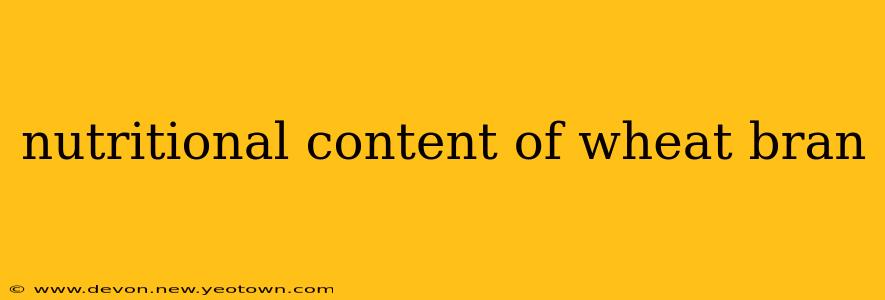Wheat bran, that often-overlooked byproduct of wheat milling, is a nutritional powerhouse brimming with health benefits. Often relegated to the side of the cereal aisle or used as an ingredient in baked goods, its true potential is often underestimated. Let's embark on a journey to uncover the secrets hidden within those humble bran flakes and understand why incorporating this nutritional champion into your diet is a smart move.
What Exactly is Wheat Bran?
Imagine a wheat kernel – it's composed of three main parts: the endosperm (the starchy part that makes white flour), the germ (the nutrient-rich embryo), and the bran (the protective outer layer). Wheat bran is essentially the tough, fibrous outer layer of the wheat kernel. It's this protective layer that holds a treasure trove of essential nutrients, often discarded during the refining process that produces white flour.
What are the Nutritional Benefits of Wheat Bran?
Wheat bran isn't just fiber; it’s a complex blend of nutrients. Let’s break down the nutritional powerhouse it truly is:
-
Fiber Champion: This is arguably wheat bran's most celebrated attribute. It's exceptionally rich in both soluble and insoluble fiber. Soluble fiber helps regulate blood sugar and cholesterol levels, while insoluble fiber promotes healthy digestion and regularity, preventing constipation.
-
Mineral Magnet: Wheat bran is a significant source of several essential minerals. These include magnesium, crucial for muscle and nerve function; manganese, vital for bone health and metabolism; selenium, a powerful antioxidant; and iron, essential for oxygen transport throughout the body.
-
Vitamin Vault: While not as abundant as in some other foods, wheat bran still provides notable amounts of certain B vitamins, including thiamin (B1), riboflavin (B2), and niacin (B3), all crucial for energy production and overall well-being.
-
Antioxidant Arsenal: Wheat bran contains antioxidants that help protect your cells from damage caused by free radicals, reducing the risk of chronic diseases.
What are the Health Benefits of Eating Wheat Bran?
The impressive nutritional profile of wheat bran translates into a range of health benefits:
-
Improved Digestion: The high fiber content is a boon for digestive health, promoting regularity and preventing constipation.
-
Lower Cholesterol: Soluble fiber in wheat bran helps bind cholesterol in the digestive tract, reducing its absorption and lowering LDL ("bad") cholesterol levels.
-
Stabilized Blood Sugar: The fiber slows down the absorption of sugar into the bloodstream, preventing spikes in blood sugar levels, particularly beneficial for individuals with diabetes or those at risk.
-
Weight Management: The high fiber content contributes to satiety, making you feel fuller for longer and potentially aiding in weight management.
-
Reduced Risk of Chronic Diseases: The combination of fiber, antioxidants, and minerals in wheat bran contributes to a reduced risk of chronic diseases such as heart disease, type 2 diabetes, and certain cancers.
How Much Wheat Bran Should I Eat Daily?
The recommended daily intake of wheat bran varies depending on individual needs and overall diet. However, starting with a small amount – about 1-2 tablespoons – and gradually increasing it over time is generally advised. Pay close attention to your body's response and adjust accordingly. Drinking plenty of water is crucial when increasing your fiber intake to prevent digestive discomfort.
Can Wheat Bran Cause Digestive Issues?
While generally beneficial, a sudden increase in wheat bran consumption can lead to digestive issues like bloating, gas, and constipation in some individuals. Introducing it gradually and drinking ample water are key to minimizing these potential side effects.
Is Wheat Bran Good for Weight Loss?
The high fiber content in wheat bran contributes to satiety, making you feel full for longer. This can help with weight management, but it's important to remember that wheat bran is just one component of a healthy weight-loss strategy that should include a balanced diet and regular exercise.
Where Can I Find Wheat Bran?
Wheat bran is readily available in most grocery stores. You can find it in its pure form (often as flakes or powder) and as an ingredient in many breakfast cereals, breads, and other baked goods.
By understanding the nutritional richness and potential benefits of wheat bran, you can make informed choices that contribute to a healthier and more balanced lifestyle. Remember to consult with a healthcare professional or registered dietitian before making significant changes to your diet, especially if you have any underlying health conditions.

